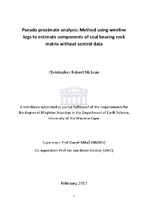| dc.description.abstract | Lab conducted proximate analysis of coal bearing rock units calculates the weight percentage of ash, moisture, fixed carbon and volatile matter through a series of combustion steps. The data obtained is quintessential in establishing the coal rank and in the case of coal bed methane the gas-in-place estimates. In this study 105 proximate analysis samples, from 7 drilled wells, are taken from the south-eastern Kalahari Basin in Botswana. The pseudo proximate analysis, the method proposed in this thesis, calculates the lab proximate analysis results using the neutron, density and gamma ray wireline logs. The uniqueness of the method lies in the fact that no cut off values are needed for the wireline logs, nor are the results of the lab proximate analysis required for calibration. An in depth study of the relationship between the wireline logs and proximate analysis is conducted using a principle component analysis and the results tested using a combination of statistical techniques to determine the significance of the relationship. It is shown that the density and neutron logs model the proportion of ash and volatile matter in the rock matrix, respectively, with a high degree of accuracy. The multiple regression analysis shows that percentages fixed carbon and moisture components of the rock matrix correlate poorly to the proposed well logs, thus most error lies in the determination of these two components. It is statistically proven that the pseudo proximate analysis results are significantly different to the lab measured proximate analysis. This implies that the proposed pseudo proximate analysis method is unable to accurately determine the components of a coal bearing rock matrix using the density, neutron and gamma ray wireline logs. The application of the proposed method is a model to identity the coal bearing rock matrix and provide a predictive estimation of the coal quality, a priori lab measured data. | en_US |

